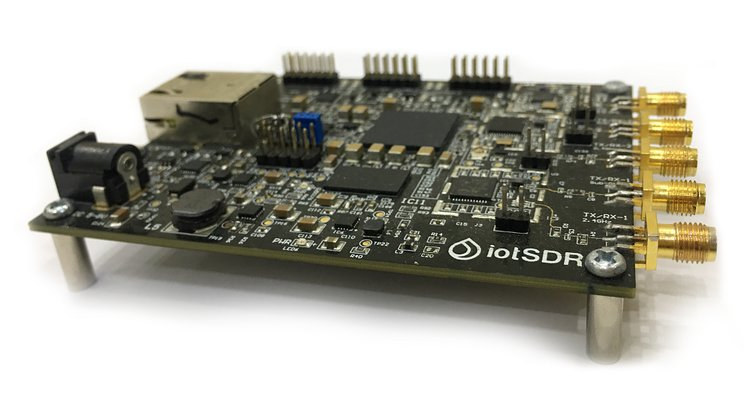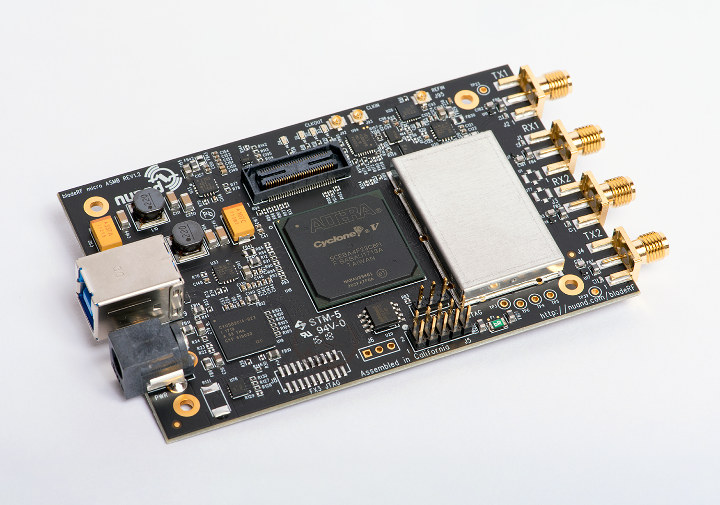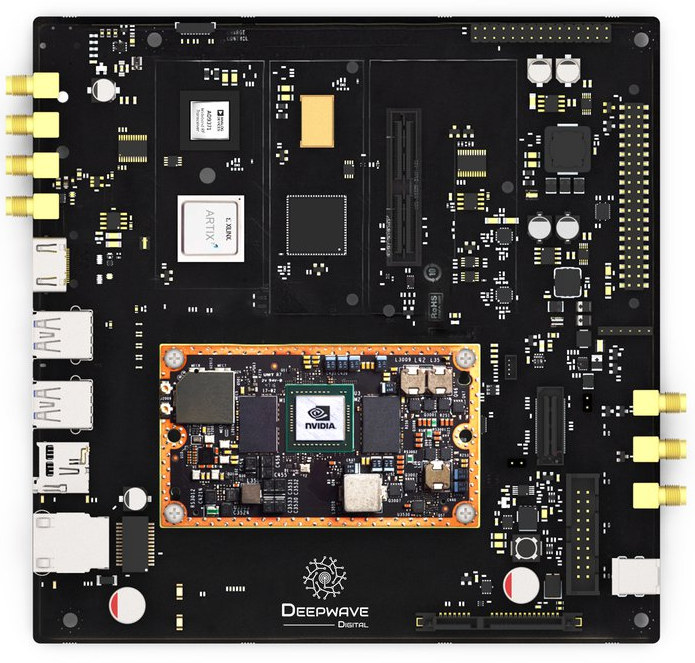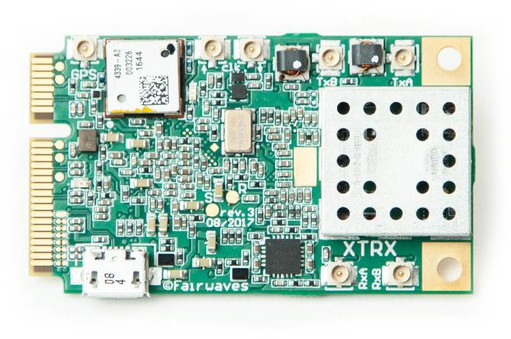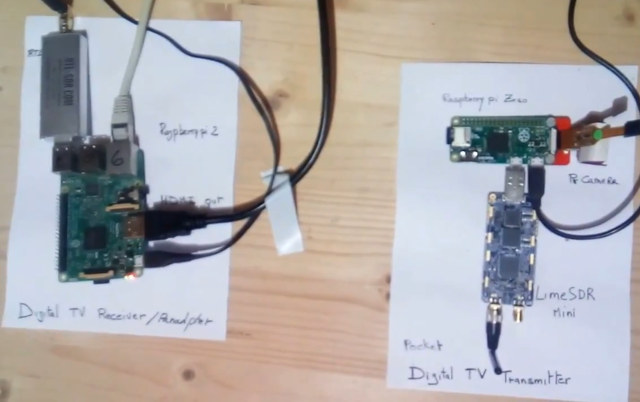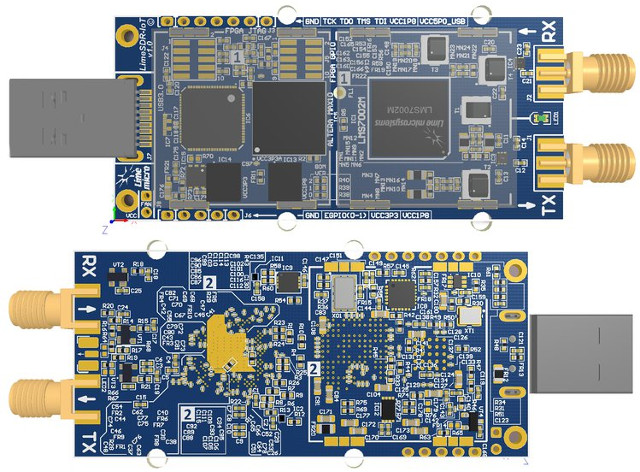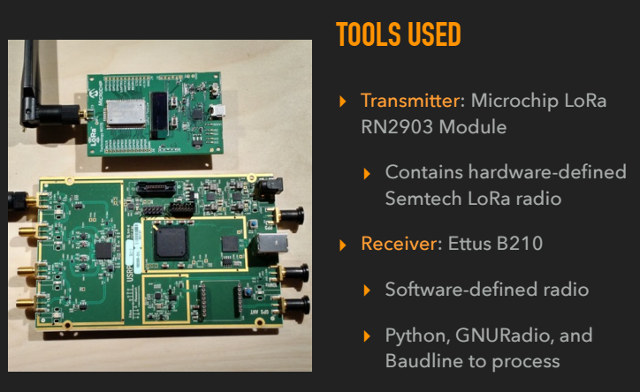Xilinx Zynq-7010/-7020 powered iotSDR board by EmbedINN enables the development of IoT gateways with support for LoRa, SigFox, WeightLess, Bluetooth, BLE, 802.15.4, ZigBee, as well as custom IoT protocols. The board also supports GPS, Galileo, Beidou, and GLONASS navigation systems thanks to a Maxim Integrated MAX2769 GNSS chip. iotSDR key hardware features and specifications: SoC (one or the other) Xilinx Zynq-Z7010 (XC7Z010-1CLG400C) dual-core Arm Cortex-A9 processor with 256 kb on-chip memory, FPGA fabric with 28,000 logic cells, 17,600 LUTs, 2.1 Mb block RAM, 80 DSP slices Xilinx Zynq-Z7020 (XC7Z020-1CLG400C) dual-core ARM Cortex-A9 processor with 256 kb on-chip memory, FPGA fabric with 85,000 logic cells, 53,200 LUTs, 4.9 Mb block RAM, 220 DSP slices System Memory – 512 MB DDR3 Storage 128 Mbit QSPI flash memory for firmware Microchip AT24MAC602 SPI EEPROM for RF transceiver MCU firmware and data Radios “IoT” Radios RF Transceivers – 2x Microchip/Atmel AT86RF215 European band – […]
BladeRF 2.0 USB 3.0 Software Defined Radio Launched for $480 and Up
Around 5 years ago, several affordable FPGA based open source software defined radio boards launched including HackRF, BladeRF x40 / x115, and USRP B200. The company behind BladeRF has now launched an update of their boards with Blade RF 2.0 coming in two versions namely bladeRF 2.0 micro xA4 and bladeRF 2.0 micro xA9 supporting the same 47MHz to 6GHz frequency range, and 61.44MHz sampling rate, but the latter comes with a more powerful 301KLE Cyclone V FPGA. BladeRF 2.0 hardware specifications: FPGA Micro xA4 – Intel / Altera Cyclone V FPGA with 49 kLE Micro xA9 – Intel / Altera Cyclone V FPGA with 301 kLE Analog Devices RF Transceiver 47 MHz to 6 GHz frequency range 2×2 MIMO, 61.44 MHz sampling rate 56 MHz filtered bandwidth (IBW) Automatic gain control (AGC) Real- time custom gain control tables controlled via SPI and discrete external input pins Automatic IQ and […]
Air-T Artificial Intelligence Radio Transceiver SDR Platform Combines NVIDIA Jetson TX2 and Xilinx Artix-7 FPGA (Crowdfunding)
If often write about low end and cheaper hardware on this blog, but not in this post. Deepwave Digital Air-T (Artificial Intelligence Radio – Transceiver) is a high-end software defined radio platform with continuous frequency coverage from 300 MHz to 6 GHz. The board combines AD9371 RFIC transceiver providing up to 2 x 2 MIMO of 100 MHz of receiving bandwidth, a Xilinx Artix-7 FPGA, and NVIDIA Jetson TX2 module. Air-T hardware specifications & key features: Software-defined Radio Analog Devices 9371 2×2 MIMO transceiver 2 x RX channels (100 MHz each) 2 x TX channels (100 MHz each) Auxiliary RX channels: Observation & Sniffer. Note: Can use either Observation or Sniffer at one time; utilizes one of the RX channels NVIDIA Jetson TX2 for processing 256 NVIDIA CUDA core GPU 6 CPU cores – 2x NVIDIA Denver2, 4x Arm Cortex-A57 8GB RAM 32GB eMMC flash Xilinx Artix-7 FPGA with75k logic […]
XTRX SDR Mini PCIe Card Supports 10 MHz to 3.8 GHz Tuning Range, up to 120 MSPS Sample Rate
Fairwaves is a startup that aims to make deploying and operating mobile networks in rural regions profitable, and their latest project is called XTRX, a high performance Software Defined Radio (SDR) board packed into a mini PCIe card form factor. The project was launched on Crowdsupply earlier with year, got fully funded by around 700 backers, and the company is now working on fulfilling backers rewards by the end of August. XTRX board specifications: RF Chipset – Lime Microsystems LMS7002M FPRF (as found in LimeSDR Mini) FPGA Chipset – Xilinx Artix 7 35T RF Channels – 2 × 2 MIMO Sample Rate – ~0.2 MSPS to 120 MSPS SISO / 90 MSPS MIMO Tuning Range: 30 MHz – 3.8 GHz Rx/Tx Range: 10 MHz – 3.7 GHz 100 kHz – 3.8 GHz with signal level degradation PCIe Bandwidth PCIe x2 Gen 2.0 up to 8 Gbit/s PCIe x1 Gen 2.0 […]
FOSSASIA Summit 2018 Schedule – March 22-25
FOSDEM is the “Free & Open Source Software Developers’ European Meeting” takes place the first week-end of February every year in Brussels, Belgium. It turns out there’s an event in Asia called FOSSASIA Summit that’s about to take place in Singapore on March 22-25. There are some differences however, as while FOSDEM is entirely free to attend, FOSSASIA requires to pay an entry fee to attend talks, although there are free tickets to access the exhibition hall and career fair. There are also less sessions as in FOSDEM, but still twelve different tracks with: Artificial Intelligence Blockchain Cloud, Container, DevOps Cybersecurity Database Kernel & Platform Open Data, Internet Society, Community Open Design, IoT, Hardware, Imaging Open Event Solutions Open Source in Business Science Tech Web and Mobile Since the event is spread out over four days, it should be easier to attend the specific sessions you are interested in. I’ve […]
Building a Compact Digital TV Transmitter with Raspberry Pi Zero, Pi Camera, and LimeSDR Mini USB SDR Board
There are few affordable standalone systems that allow you to transmit video over the air, and back in 2016, I had the chance to check out V-Bridge Muses-β MPEG-2/-4 encoder and DTV modular taking HDMI or composite video input. It was easy to use and worked fine, but it would still cost close to $600, and might have been a little smaller. Evariste Okcestbon has now created its own digital TV transmitter prototype, combining LimeSDR Mini USB SDR board with Raspberry Pi Zero board, and instead of supporting external input from HDMI or AV ports, he used an official Pi camera for video, and was able to transmit the video over a 1.2 GHz connection to a Raspberry Pi 2 with an RTL-SDR dongle, with the Pi 2 board also taking care of displaying the video signal. The full flow of transmission can be summarized as follows: Video from […]
LimeSDR Mini is a $135 Open Source Hardware, Full Duplex USB SDR Board (Crowdfunding)
LimeSDR open source hardware software defined radio was launched last year with the promise of integration with Ubuntu Snap Store allowing to easily download and install various radio implementations such as LTE, WiFi, Bluetooth, LoRa, etc… It was offered for $200 and up as part of a crowdfunding campaign, but Lime Microsystems is back on CrowdSupply with a cheaper and low end version aptly called LimeSDR Mini.LimeSDR mini specifications: FPGA – Intel Altera Max 10 (10M16SAU169C8G) with 16K Logic gates, 549 KB M9K memory, 2,368 KB user flash memory Storage – 4 MB flash memory for data; 2x128KB EEPROM for RF transceiver MCU firmware and data RF Lime Microsystems LMS7002M RF transceiver Tx & Rx SMA connectors Frequency range – 10 MHz to 3.5 GHz RF bandwidth – 30.72 Mhz Sample Rate – 30.72 MSps with 12-bit sample depth Power Output (CW): up to 10 dBm USB – 1x USB […]
GR-LoRa is a Reverse-Engineered Open Source Implementation of LoRa PHY
LPWAN standards such as LoRa or Sigfox allow you to transmit data over long distance, at ultra low power (up to 10 years on a AA battery), and for free if your use your own network (P2P or gateway), or a few dollars per years if you go through a network provider. The low cost is possible since those standards rely on 900 MHz ISM bands, meaning nobody has to pay millions of dollars to the government to obtain a license fee. Matt Knight looked at LoRa, and while Level 2 and 3 of the protocol (LoRaWan) has public documentation, Level 1 (LoRa PHY) is proprietary and the standard is proprietary. So he decided to reverse-engineer LoRa PHY using Microchip RN2903 based LoRa Technology Mote and Ettus B210 USB software defined radio, and software packages and tools such as Python and GNU Radio to successfully deliver GR-LoRa open source “GNU Radio […]


